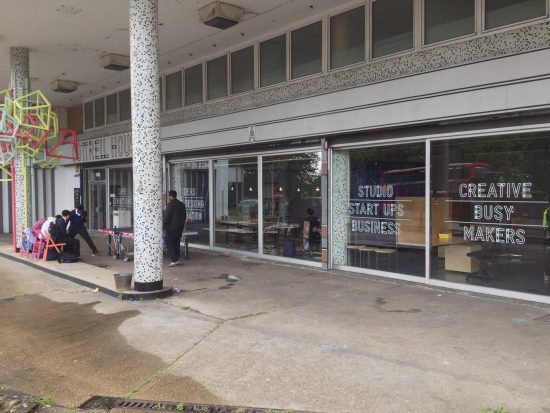Temporary use is a learning process of accommodating innovation and adapting needs and capacities to available resources. It offers benefits to owners and users, in terms of security, maintenance, anchor tenants and social vibe on the one side, and affordable rents and spaces on the other. And it can help shaping new forms of cooperation between public administrations, private property owners and citizen initiatives.
To enable temporary use, authorities need to recognize the values of bottom-up undertakings and adapt their regulations to support them. To fulfil their public duties, local governments need to enable community organizations to develop neighbourhood services. To engage their citizens, administrations need to help connecting supply with demand and open the doors of their unused properties to accommodate civic innovation.
This article, based on the authors’ work in the URBACT knowledge transfer program Temporary Use as a Tool for Urban Regeneration and other initiatives and research, looks at a few examples to explore the conditions and potentials of temporary use in regenerating European cities and giving communities better access to urban spaces.
When Willemijn de Boer, founder of ANNA Real estate+culture began to rent the ex-Europol building from the Dutch government in 2010, she did not know that she would still be in the building five years later. The 14.000 m2 complex, including a former school building adapted to the police organization’s needs, and a modern office wing attached to it later, is situated at the edge of The Hague’s international district. Located between highways, office buildings and a prosperous residential neighbourhood, the former police station is now more open to the neighbourhood than ever: its well-kept garden is accessible from the street, making passersby wonder about the new function of the complex.
The building is in temporary use: while waiting to be sold, it is rented to ANNA with a one-month moving out notice; the agency then gives the opportunity to about 50 people, organisations or companies to rent affordable offices, showcases or studios. The tenants are typically artists, musicians, designers, architects and cultural producers, flexible enough to pack and move to the next building when they have to. Taking risk paid them back: selling the building proved to be more complicated than planned, and many of them have been enjoying the advantages of low rents for years, enabled to concentrate on their work. The building’s public owner also benefits from the situation: while accommodating temporary users is much cheaper than hiring a security company to protect the building, ANNA keeps the building tempered and tidy, and the building contributes to the cultural vibe of the city.
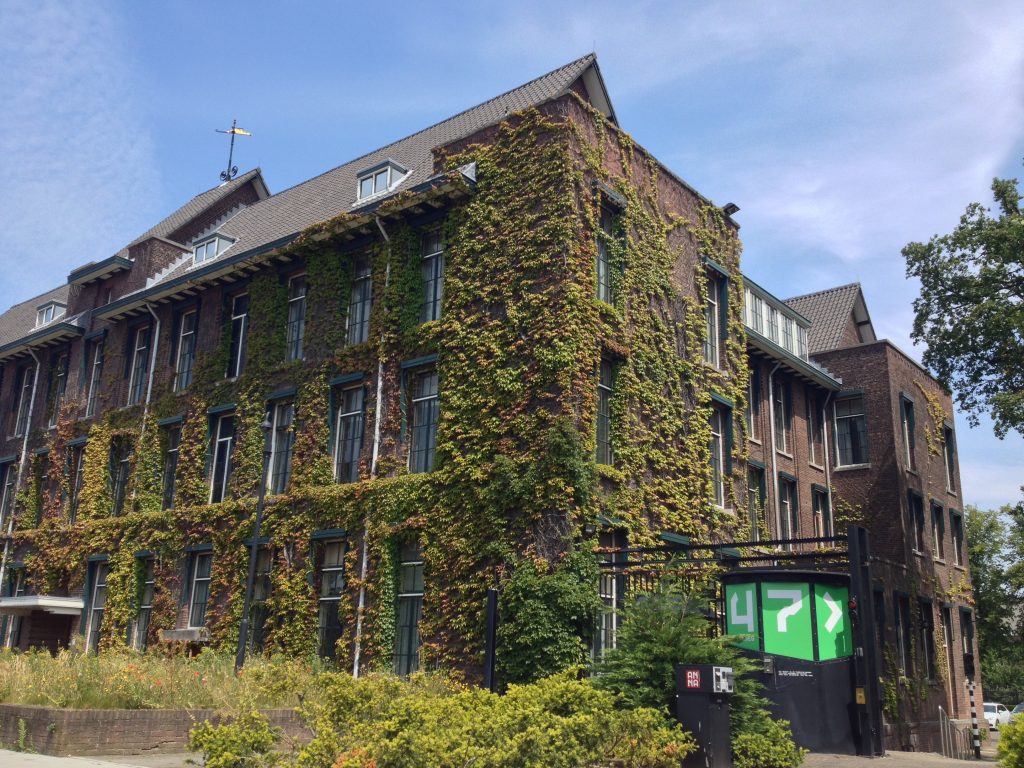
A few hundred kilometres to the southwest, 6B, an independent cultural centre was born from a similar situation. Located in Saint-Denis, a northern suburb of Paris, the former Alstrom building that accommodates 6B is part of a large-scale urban development project. When Julien Beller, member of the architecture collective exyzt began negotiating with the building’s owner in 2009, the 7000 m2 building was not attractive to larger companies: it was planned to be demolished two years later. Beller, together with a group of artists and architects, saw opportunities in the building. Taking the risk of moving in for a limited period of time, they mobilized their networks and quickly filled the entire building.
In a few years’ time, 6B has become a major cultural venue in the Parisian agglomeration: renting 160 units to individuals, associations and enterprises adding up to about 300 people, with different activities and incomes, it feels more like a neighbourhood than an office building. Gradually turned into an asset in the developer’s eye, and acting as a site of cultural exchange and social cohesion, 6B’s building is no longer on the demolition list: it has been integrated in the area’s development plans and the association managing the centre is now looking for ways to buy the complex.
Understanding the centre’s importance in bringing cultural activities and creative jobs in a neighbourhood in transition, even the region of Ile-de-France rents offices in the building, thus keeping a foot in one of the most interesting urban experiments of the Grand Paris. Beller welcomes the public administration among the building’s tenants:
“A cultural project can cost a hundred million euros, or zero. This one costs zero. In order to survive, to have places to create and work, we have to invent new models. Those models cannot be made by the administrations because they don’t have the money anymore. We have to create them, by organizing ourselves and then connecting with public policy.”

6B and the ex-Europol building represent two distant cases of temporary use. They were both born in vacant buildings that lost their functions, using the time in-between two regular uses, a period of often unpredictable length before selling or demolishing a building. They both offer benefits to owners and users, in terms of security, maintenance and anchor tenants on the one side, and affordable rents and spaces for cooperation on the other. And they both inspire a learning process at administrations, challenged to accommodate innovation from the civic society, and at communities, required to adapt their needs and capacities to available resources. There are also differences between them: the ex-Europol complex is publicly owned; 6B was born in a private property. The Hague project was conceived with a minimum perspective of one month, the Saint-Denis experiment with two years.
Despite their differences, they signal an emerging phenomenon all across Europe: the experimental reuse of vacant buildings. First explored in the transforming Berlin of the 1990s and 2000s, and later developed into a set of methodologies, temporary use has become and attractive and efficient tool to tackle the problem of vacant properties. In the years after the eruption of the 2007-2008 economic crisis, with many municipalities struggling to maintain their infrastructures, or forced by austerity policies to downscale and outsource their services, involving community energies in running services and spaces seems like a logical idea.
Referring to a wide range of activities, temporary use has been adopted in different contexts. While many European cities witnessed isolated experiments of temporary use, some local administrations have been seeking to structure these initiatives by creating frameworks to facilitate the process of reusing vacant properties.
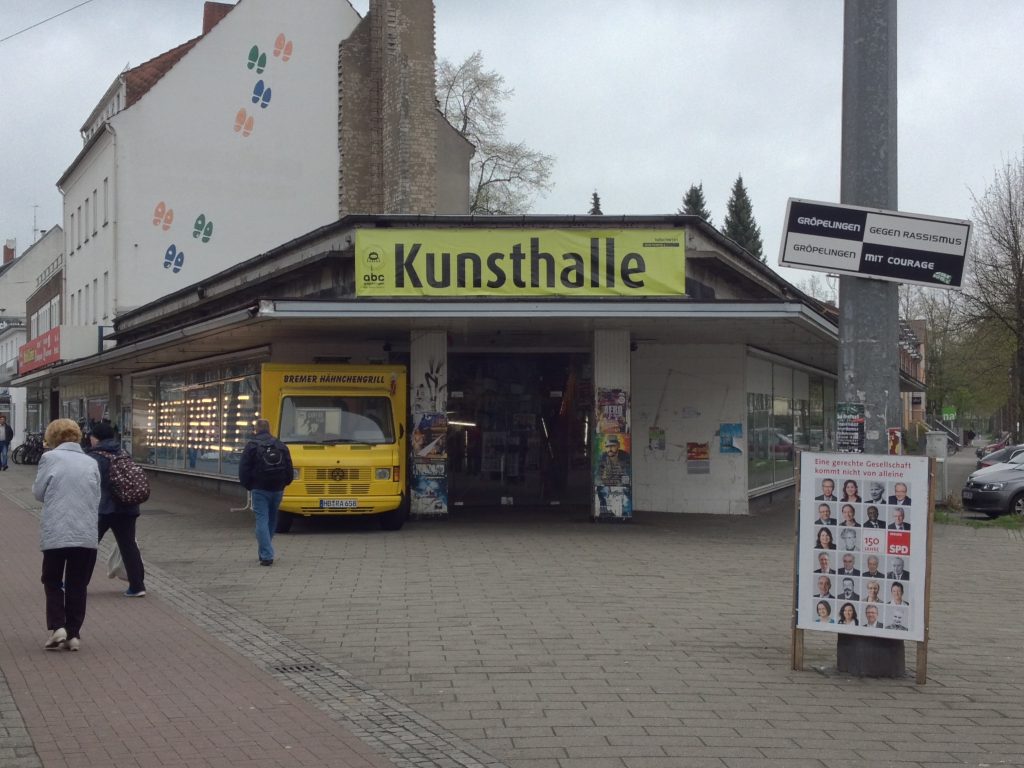
The City of Bremen saw vacancy as an opportunity to address its demographic challenges. Eager to revitalize its economy and keep young graduates in town, the municipality began to regenerate its brownfields, turning industrial buildings into artist studios, incubators and working spaces. In the late 2000s, the city of Bremen came up with the idea of a temporary use agency for the whole city as a pilot project of the Nationale Stadtentwicklungspolitik, a program of the Federal Ministry of Building. The impulse for a temporary use of agency in Bremen came from the Department of Economics, Labour and Ports in 2007. As Kai Stührenberg, head of the Department explained, temporary use was seen first of all as an economic regeneration strategy:
“Temporary use is very important because we have to deal with very small companies, freelancers, people who don’t earn much money, mostly in the beginning of their career, so it’s very important to have low rents and to have very inspiring surroundings.”
Recognizing the limits of the outreach to representatives of the creative industries, city officials decided to involve an agency that can connect owners and users, the administration and young entrepreneurs. Through an open call in 2009, the municipality selected a group of architects to run the agency baptised ZwischenZeitZentrale. Although all municipal departments and public companies support its activities, the agency’s strength lies in its mediating capacities:
“We have many buildings owned by the administration, and the ZZZ makes the link between them and the potential users: they know the projects and the buildings, they act as translators between the administration’s bureaucracy and people who have a different language.”
Other models of temporary use agencies were created outside of municipalities. Meanwhile Space, a London-based community interest company grew out of a nationwide initiative called the Meanwhile Project, aiming at boosting community uses of empty properties. The project, besides developing a series of temporary use toolkits, also set up networks of property owners, prospective users and local authorities interested in creating accessible spaces for entrepreneurs, social initiatives and community groups.
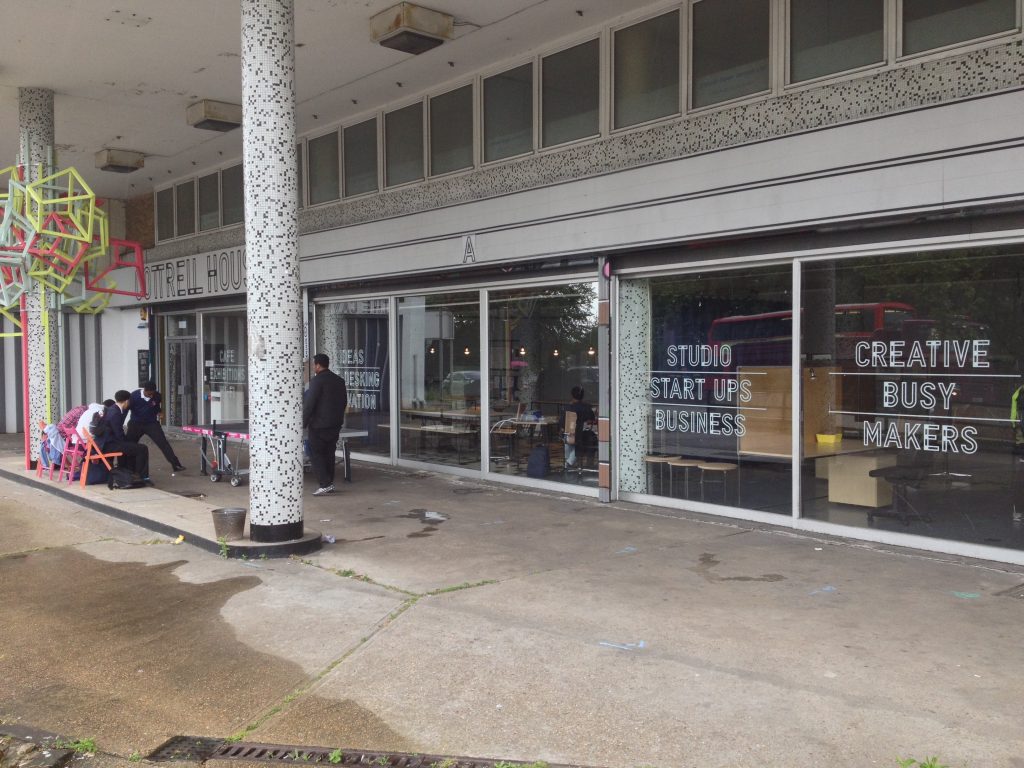
The work of Meanwhile Space has been facilitated by the Rating (Empty Property) Act adopted in 2007 by the national government. Increasing the empty property rate from 50% to 100% of the basic occupied business rate, and allowing for tax exemptions for properties that accommodate charities or non-profit organisations, the law encourages private owners to give community initiatives access to their properties.
Since its formation in 2009, Meanwhile Space gave access to vacant spaces to about 1100 people, helping owners to save over 600.000 pounds in property taxes. In projects like the Wembley-based “Cottrell House” where they created an incubator space for over 40 local companies, Meanwhile Space works closely with local administrations. Emily Berwyn, the organisation’s founder emphasizes the importance of cooperation with municipalities:
“We work with them to help them understand how they could facilitate these kinds of projects, we held many interesting workshops with the different departments, we developed with them Action Plans, looking at how they could maximize the use of the space they have and will have in the coming months in the area, and how they can enable that as a regeneration tool to enhance economic activity.”
In contrast to the agency model developed in The Hague, Bremen or London, many cities experience unmediated initiatives to gain access to vacant properties and sites. In these cities without adequate frameworks for temporary use, administrations acting in response to citizen pressure have to reinvent each time the modalities of community access to and management of publicly owned spaces.

In Madrid, after the construction of a market hall and a sports centre in the La Latina neighbourhood was interrupted by the economic crisis, Campo de Cebada was abandoned until a festival installation created a temporary swimming pool and a concert venue at the halted construction site. The installation helped locals to discover their unused spatial asset, and when the installation was dismantled after the festival, the community reclaimed the square and began to project their ideas into the space. As a result of the reunions and assemblies gathering an increasing number of people, the community formed an association and gave a formal proposal to the municipality. Accepting the proposal, the municipality signed a temporary cession with the association that began managing the space in 2011, running it as a sports field, a meeting point and an event venue for concerts and film screenings.
In Rome, where austerity measures and the economic crisis brought about the closure or the privatization of dozens of cinemas, theatres, schools, libraries and markets, the local administration has received an increasing pressure from citizen organizations demanding better services and access to public properties. In response to the occupation of numerous buildings in the past years, and in competition with each other, municipal departments developed a series of frameworks to give communities access to public properties and land. “Terre Pubbliche” is a competition for the assignment of abandoned public land to young cooperative of farmers, initiated after the occupation of Borghetto San Carlo. The “Delibera per spazi Verdi” of the Environment Department aims at allocating abandoned green land to neighbourhood associations to create playgrounds and gardens. The Real Estate Department promoted both the “Delibera Patrimonio di idee”, giving neighbourhood associations access to abandoned public properties to neighbourhood associations, and the call “Patrimonio Bene Comune” offering residual spaces for innovative cultural or entrepreneurial uses.
The parallel, uncoordinated emergence of these initiatives is a sign of the difficulties of the Rome administration to create an inter-sectorial governance model; the URBACT project Temporary Use as a Tool for Urban Regeneration, initiated by the Planning Department, pursued a higher synergy amongst administrative actions. The TUTUR project’s aim was to develop transformations where the administration could play an active role as a broker for socially engaged regeneration projects in the city. The municipality experimented with meanwhile uses on various locations, including a food market identified by the local district council as a valuable public infrastructure, potentially providing local services at neighbourhood level and fostering economic activities though the metropolitan food production.
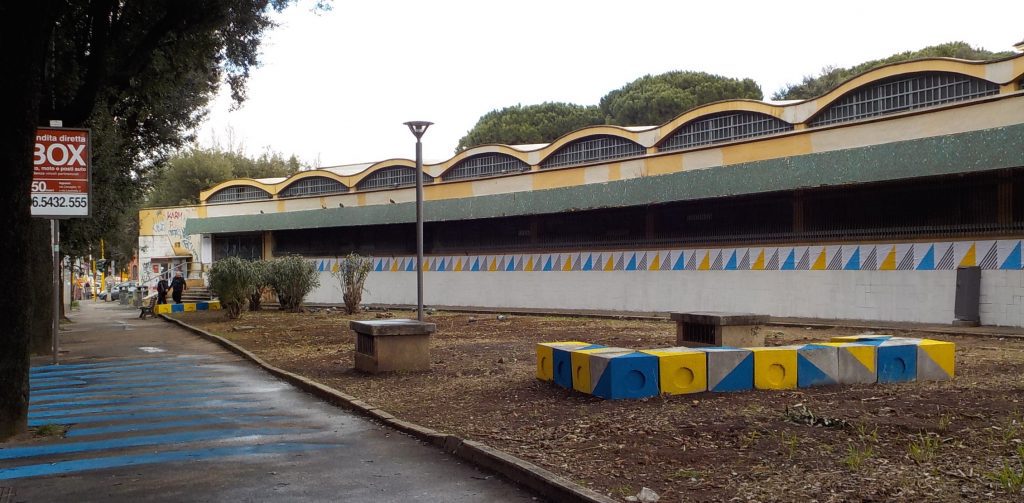
The TUTUR project’s legacy is manifold. On the one hand, the experience of opening publicly owned spaces for community use has fed into the municipality’s efforts to develop new policies inspired by Bologna’s Regulation of the Commons, defining the modalities of collaboration between the administration and citizens in using and managing public properties. On the other hand, the project contributed to a growing awareness among municipal officers and decision-makers of the need of mapping public assets and potential users.
Rome is not alone with this recognition: as the Athens Municipality’s Synathina map of social initiatives teaches us, in order to renew their practices, authorities need to learn from civic initiatives, recognize the values of bottom-up undertakings and adapt their regulations to support them. In order to maintain their leadership, municipalities need to help connecting supply with demand, by making visible unrecognized resources and enabling cooperation between different actors. To fulfil their public duties, local governments need to enable community organizations to develop neighbourhood services. To engage their citizens, administrations need to open the doors of their unused properties and accommodate innovation.
Daniela Patti & Levente Polyak

